Industrial compound feed production in the EU-27 is expected to decrease in 2024 by 0.3%, based on data collected by the European Feed Manufacturers’ Federation (FEFAC). If realized, it would mark the fourth straight year of declining feed output in the EU.
In its latest report, released on May 30, FEFAC said the outlook for EU compound feed production in 2024 presents a mixed picture, “reflecting varying trends across livestock sectors and influenced by economic, regulatory and environmental factors.”
Poultry feed production is the only sector showing growth prospects in 2024, with an anticipated increase of 1.6%, FEFAC said. The rebound follows a challenging 2023 driven by recovering poultry production in several key member states.
“Countries like France, Spain and Portugal, as well as Italy, already experienced some recovery from AI (Avian Influenza) impacts in 2023, and are expected to continue leading this growth,” FEFAC said. “However, concerns about imported poultry meat and shifts from organic production toward standard conventional production may affect overall market dynamics.”
FEFAC noted that the pig feed sector will face continued challenges, with a projected decline of 1% to 2% in 2024. Factors such as a decrease in the number of pigs and economic and disease pressures on farmers, including African swine fever (ASF), will continue to adversely impact production, the report said. However, Ireland and Poland expect a modest recovery (3% and 2.7%, respectively) in pig numbers, contributing to a slowdown of the decrease of the sector’s output.
Other countries like Germany, Belgium and the Netherlands point to continued political pressure to reduce farm emissions or the scale of animal husbandry, resulting in a high level of uncertainty for the sector’s outlook.
Cattle feed production is expected to remain relatively stable, with minor growth or reduction depending on regional conditions. FEFAC said. It noted that Ireland expects modest growth in cattle feed due to a delayed grazing season. Conversely, the Netherlands “anticipates further decreases in dairy and beef sectors (down 5%), driven by ongoing regulatory and environmental challenges.”
EU feed production has declined every year since 2020, according to Alltech’s annualglobal feed production survey.




